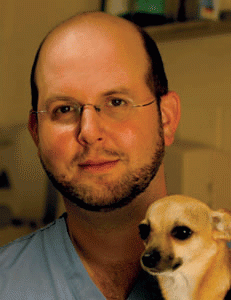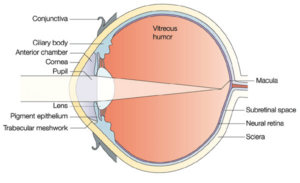-
Adopt
-
Veterinary Care
Services
Client Information
- What to Expect – Angell Boston
- Client Rights and Responsibilities
- Payments / Financial Assistance
- Pharmacy
- Client Policies
- Our Doctors
- Grief Support / Counseling
- Directions and Parking
- Helpful “How-to” Pet Care
Online Payments
Emergency: Boston
Emergency: Waltham
Poison Control Hotline
-
Programs & Resources
- Careers
-
Donate Now
 by Dan Biros, DVM, DACVO
by Dan Biros, DVM, DACVO
www.angell.org/eyes
ophthalmology@angell.org
617-541-5095
The fluid in the anterior and posterior chambers of the eye, known as the aqueous humor, is a remarkable composition of biological molecules that are actively working to vitalize and protect the surrounding ocular environment. As an integral part of the visual axis, the aqueous humor must remain clear to enable vision and at the same time serve a critical supporting role for ocular health. When injured, the components of the aqueous humor change to reflect the nature of the insult. After the eye recovers fully from disease or injury, the body restores the aqueous humor to its innate, or ‘pristine’ condition involving a complex arrangement of mechanisms both anatomical and immunological. We will explore a few of these factors in some detail.
The anterior chamber is lined by the cornea anteriorly, the lens posteriorly, and the uveal tissue, including the iris and ciliary body peripheral to the axis of vision (Figure 1). The aqueous humor fills the anterior chamber and the posterior chamber and in dogs and cats is about 1 ml volume or more (by contrast to humans who have an anterior chamber volume of about 0.3-0.5 ml). It is produced by the ciliary body which is a part of the eye rich in antioxidant systems with functional levels of catalase, superoxide dismutase, and glutathione peroxidase. The ciliary body also is the primary area within the eye where drugs are detoxified via cytochrome P450 pathways within the cells’ microsomes.
The refractive index of aqueous humor is 1.335, slightly denser than water. There is a unidirectional flow of aqueous humor through the anterior chamber, starting at the ciliary body processes, traveling through the posterior chamber and into the anterior chamber where it exits at the iridocorneal angle. Aqueous humor is considered an ultrafiltrate of plasma, containing ions, proteins, carbohydrates, and oxygen, which supports the nourishment of the ocular tissue. It is also able to transport lactate, urea, and other waste products from tissues lining the anterior and posterior chambers back into the blood stream for disposal.
Aqueous humor is formed by three mechanisms: diffusion, ultrafiltration, and active secretion by the non-pigmented ciliary epithelium. Water reacts chemically with carbon dioxide via the carbonic anhydrase enzyme creating bicarbonate and a hydrogen ion:
CO2 + H2O → HCO3- + H+
This reaction provides a significant means for water to get into the ciliary epithelium from the vasculature and ultimately into the aqueous humor. Another way the aqueous is formed is through the cAMP-dependent activity in the ciliary processes. Stimulation of β2 receptors on the ciliary body vasculature by circulating epinephrine increases aqueous formation through increased cAMP activity. By contrast, stimulation of α2 receptors on the vasculature of the ciliary body by norepinephrine decreases aqueous formation through decreased cAMP activity. Within the anterior chamber there are thermal currents that move the aqueous humor from the iris to the cooler cornea. When there is anterior uveitis, the cellular precipitates in the aqueous humor can sometimes be seen on the posterior surface of the cornea in streaks or spindles due to this inherent current.
The major cations in the aqueous humor are sodium, potassium, magnesium, and calcium, with sodium making up about 95% the cations present. Na+ is actively transported from the ciliary epithelia into the aqueous humor via the Na+, K+ -ATPase enzyme complex. This causes an osmotic influx of water, which also drives aqueous humor production (in addition to active secretion). The primary anions in the aqueous humor are chloride, bicarbonate, phosphate, ascorbate, and lactate. Levels of these anions and cations in the aqueous humor can be greater than or less that their concentration in the plasma depending on the species.
Other chemical components in the aqueous humor include immunoglobulins, neuropeptides, lipids, and enzymes typically at levels below that found in plasma. Carbohydrates enter the aqueous by diffusion, and the gradient in part is thought to be driven by the consumption of carbohydrates by the lens and cornea.
The aqueous humor also has immunomodulatory properties at functional concentrations that can alter conditions in the eye when the eye is threatened with or recovering from inflammation. When macrophages come in contact with aqueous humor (which contains the anti-inflammatory protein transforming growth factor 2 (TGF-β2)), they alter their functionality by producing more TGF-β, preventing the production of proinflammatory IL-12, and deviating from their usual manner of antigen presentation. These newly transformed macrophages stimulate a population of CD8+ suppressor cells inhibiting proinflammatory immune responses. These functionally altered macrophages also mediate immune responses that induce non-complement fixing antibody production by B cells. All of these mechanisms protect the eye from the damaging effects of inflammation.
There are many other factors in addition to TGF- β2 in the aqueous humor. Most of these factors contribute to suppressed proinflammatory cytokine interferon-gamma (IFN-g) production by immune cells. Vasoactive intestinal peptide (VIP) and somatostatin suppress antigen and mitogen mediated T cell proliferation. The neuropeptide alpha-MSH suppresses IFN-g production by T cells but does not suppress T cell proliferation. TGF- β2 with α-MSH can also directly suppress activation and proliferation of proinflammatory T cells. α-MSH with or without TGF- β2 can also induce a population of immune cells with antiinflammatory properties. Further, effector CD4+ (but not CD8+) T cells that enter the healthy eye do not carry out their effector functions but rather are converted by the local soluble factors into regulatory cells that can suppress other activated T cells. The induction of these regulatory cells may also be important in maintaining tolerance to autoantigens.
Aqueous humor factors can also inhibit innate immune cell function. Calcitonin gene-related peptide (CGRP) inhibits nitric oxide formation from stimulated APC’s. Migration inhibitory factor (MIF) inhibits NK cell mediated lysing of target cells. Both the molecule Fas-L and α-MSH inhibit neutrophil function. Complement activation is also prevented by at least two soluble aqueous humor factors. One factor, iC3b prevents C3 conversion to C3b and another separate factor prevents antibody binding to C1q.
Aqueous humor plays an active role in maintaining the ocular health. It is derived from plasma and is formulated as such to nourish the ocular tissues and protect the eye from the devastating effects of inflammation. When the eye recovers from inflammation, the factors in the aqueous humor are in the forefront of the process of restoring the eye to normal function.
For more information about Angell’s Ophthalmology service, please visit www.angell.org/eyes. Drs. Coster and Biros are available for consults or referrals at 617 541-5095, or e-mail ophthalmology@angell.org.
References
Gum GG, et al. Physiology of the eye. In: Gelatt KN ed. Veterinary Ophthalmology. Ames: Blackwell, 2007.
Caprioli J. The ciliary epithelia and aqueous humor. In: Hart WM, et al, eds. Adler’s Physiology of the Eye. St. Louis: Mosby, 1992.
Biros D. Ocular Immunity. In: Gelatt KN ed. Veterinary Ophthalmology. Ames: Blackwell, 2007.
